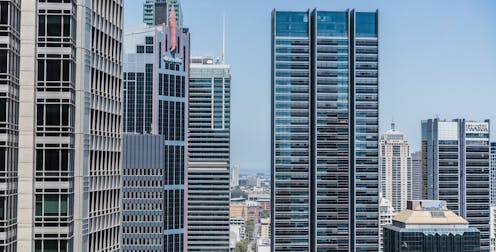New survey shows business outlook is weakening and uncertainty rising as the trade war bites
- Written by John Simon, Adjunct Fellow in Economics, Macquarie University

Uncertainty is everywhere these days.
There is even uncertainty about the uncertainty.
The Reserve Bank of Australia, for example, noted in the minutes from its April 1 meeting[1]:
The most significant development in the period leading up to the meeting had been the significant rise in uncertainty about global trade policy, although the effect of this on sentiment and economic developments in Australia was not yet clear.
A new monthly business survey, developed by a team of researchers at Macquarie University, the Business Outlook Scenarios Survey (BOSS)[2], provides some clarity.
A key feature of the survey, which distinguishes it from other business surveys, is its focus on uncertainty about the future, not just expectations about the most likely outcome.
The most recent survey was conducted between April 10–17, after the announcement of the US “liberation day” tariffs[3] on April 2. The results are concerning, but not yet alarming.
Big rise in uncertainty
The results suggest there has been a significant increase in business uncertainty stemming from the tariff and geopolitical tensions.
Our survey asks roughly 500 Australian businesses about their expectations for, and perceptions of uncertainty about, key business and macroeconomic conditions.
Running since June 2024, it tracks a sample that is representative of Australian businesses. It surveys key decision makers, such as chief financial officers and business owners, who have a detailed knowledge of their own business, and a general knowledge of the broader economy.
The jump in uncertainty is leading to an increase in pessimistic views about businesses’ prospects. Moreover, these expectations are surrounded by elevated uncertainty.
While this has yet to translate into plans to reduce employment and investment, businesses on average expect their costs will rise, and plan to counter the effect through increasing prices.
More importantly, uncertainty generally leads people to defer decisions, and we see evidence of that in the April survey. Firms on average are not expecting to reduce investment or employment – but neither are they planning on increasing it.
Inflation worries are off the boil
When asked about the main source of uncertainty over the next 12 months, businesses used to point to inflation. In June 2024, more than 65% of businesses cited inflation as the main source of business uncertainty. While this is still a significant concern, it has fallen to 48% of respondents.
More dramatically, however, geopolitical risk and tariffs combined were nominated by 52% of businesses in April as one of the main sources of uncertainty. This is up from about 20% of firms in June last year.
This global uncertainty is translating into uncertainty about individual business conditions. There is an increase in the percentage of businesses that expect deteriorating conditions for their business. And there is also an increase in uncertainty about the likely outcomes for their industry conditions, product demand, and access to credit and business inputs.
Risks for hiring and investment
While deteriorating expectations are a source of concern, the rise in uncertainty is like a one-two punch. Businesses that are uncertain about the future will stop hiring or investing until they have a better idea of what the future holds.
Indeed, during the Great Depression in the 1930s, uncertainty about the future exacerbated the initial downturn and helped turn it from a recession into a depression. This paralysing uncertainty is what led US President Franklin D. Roosevelt to utter the famous line “the only thing we have to fear is fear itself[4].”
While the situation in Australia is not nearly that dire, you can see the consequences of the uncertainty in businesses’ expectations for both their own businesses and the economy more generally.
In light of the tariff tensions, the majority of businesses are adopting a “wait and see” approach and expect to keep employment and investment unchanged in the next 12 months. The majority (62%) also expect their costs will be higher and, consequently, that they will have to raise their prices.
What it means for the RBA
Most businesses surveyed also anticipate higher inflation and lower economic growth in Australia. That is, stagflation[5].
This has important consequences for the next Reserve Bank board meeting in May.
The March quarter consumer price index[6], to be released on April 30, is unlikely to show the effects of the trade tensions. But monetary policy needs to be set in a forward-looking manner. That means business expectations of higher costs, prices and inflation over the next 12 months could argue for higher interest rates than otherwise.
Complicating the picture is the expectation of slower economic growth, which would usually argue for lower interest rates.
On balance, the majority of businesses surveyed in April expect the Reserve Bank to lower the cash rate in response to the trade war.
Regardless, what is undeniable is that uncertainty has increased in the last few months. And that means that policymakers need to deal with the uncertainty itself. Slightly lower interest rates or a little extra government spending cannot, of themselves, overcome the paralysing effects of uncertainty.
As such, the Reserve Bank and the government need to talk about not just their central expectations, but their strategy for dealing with the uncertainty around those expectations.
References
- ^ the minutes from its April 1 meeting (www.rba.gov.au)
- ^ Business Outlook Scenarios Survey (BOSS) (www.mq.edu.au)
- ^ tariffs (theconversation.com)
- ^ the only thing we have to fear is fear itself (www.fdrlibrary.org)
- ^ stagflation (www.investopedia.com)
- ^ consumer price index (www.abs.gov.au)
Authors: John Simon, Adjunct Fellow in Economics, Macquarie University







